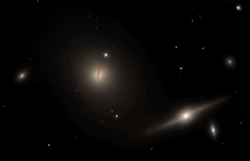| NGC 708 | |
|---|---|
 NGC 708 imaged by Pan-STARRS | |
| Observation data (J2000 epoch) | |
| Constellation | Andromeda |
| Right ascension | 01h 52m 46.4467s [1] |
| Declination | +36° 09′ 06.581″ [1] |
| Redshift | 0.015886 [1] |
| Heliocentric radial velocity | 4762 km/s [1] |
| Distance | 232.05 ± 16.32 Mly (71.147 ± 5.005 Mpc) [1] |
| Group or cluster | Abell 262 |
| Apparent magnitude (V) | 13.70 [1] |
| Characteristics | |
| Type | E [1] |
| Size | ~200,000 ly (62 kpc) (estimated) [1] |
| Apparent size (V) | 3.0′ × 2.5′ [1] |
| Other designations | |
| B2 0149+35, HOLM 049A, UGC 1348, MCG +06-05-031, PGC 6962, CGCG 522-039 [1] | |
NGC 708 is an elliptical galaxy located 240 million light-years away [1] in the constellation Andromeda. It was discovered by German-British astronomer William Herschel on September 21, 1786. [2] It is classified as a cD galaxy [3] [4] and is the brightest member of Abell 262. [5] [6] NGC 708 is a weak [7] FR I radio galaxy [8] [9] [10] [11] [12] and is also classified as a type 2 Seyfert galaxy. [7] [13] [1]
Contents
- Dust lane
- Supermassive black hole
- Radio morphology
- Possible interaction
- See also
- References
- External links
NGC 708 is surrounded by 4,700 globular clusters. [14]
